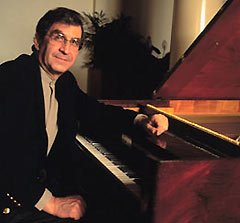 The Shriver Piano Celebration is much more than just three recitals (actually five – but Ionarts will wait until Kit Armstrong can reach the pedals before we review him; McCoy Tyner, an original member of the John Coltrane Quartet, is admired by us but outside our expertise) but also a series of lectures including one by the New York Review of Books’ Michael Kimmelman. I missed that, sadly, but hey: 11.30AM… that’s just not realistic. What we would not have missed; did not miss, was a “recital with commentary” by one of the foremost ‘fortepianists’, Malcolm Bilson.
The Shriver Piano Celebration is much more than just three recitals (actually five – but Ionarts will wait until Kit Armstrong can reach the pedals before we review him; McCoy Tyner, an original member of the John Coltrane Quartet, is admired by us but outside our expertise) but also a series of lectures including one by the New York Review of Books’ Michael Kimmelman. I missed that, sadly, but hey: 11.30AM… that’s just not realistic. What we would not have missed; did not miss, was a “recital with commentary” by one of the foremost ‘fortepianists’, Malcolm Bilson. W. A. Mozart, Complete Piano Concertos, Bilson / Gardiner / ORR |
Before playing the Mozart Fantasy in C Minor, K. 475, “the ultimate fortepiano piece,” Bilson demonstrated the differences between the sound of a note played on a modern grand (a Steinway was conveniently parked right next to his Streicher copy); illustrating how on the modern instrument a tone rises after being struck, stays at a plateau for a while only to decay very slowly. The fortepiano, instead, presented one little ‘hump’ of sound after striking the strings, decaying rapidly thereafter. The former’s prowess of legato and staccato allowing for excellent blending and coloring, the latter (with its flatter, plumper attack) being superior in presenting independent voices. A short foray into natural tuning (explaining otherwise boring repetition of a melody or sequence in different keys as actually sounding different from one another) and off he was in his mission to remove the schmutz and patina of modern, well-tampered performances from the Mozart.
The ‘disadvantage’ of the fortepiano’s sound production was made use of in little, quickly fading, left-hand hammerblows that could be played with so much more gusto without destroying the balance or covering the right hand’s Waldstein-like accompaniment. The notes here, as generally speaking, were dry, hard-smacked, capped… a musical pebble-parade of small tones, washed round. The independence given to the accompaniment means that it need not ‘hide’ behind the music, allowing the non-dominant hand much more freedom to attack as it pleases. It’s easy to recklessly crash chords together without having to deal with the consequences. In sonata K. 332 Bilson created a tempest-in-a-teapot quality, an adorable (although impotent) rage of attacking wildly only to be thwarted by the minimal half-life of the struck notes. But then, that little tempest may not be so inaccurate or unwanted in the sonata. The instrument, meanwhile, allows for faster playing with less reverb not smudging all the details – and Bilson made good use of that in his brisk performance… even if recent scholarship suggests that solo keyboard works were actually played much slower in the past – as opposed to (especially Romantic) orchestral music which has only been slowed down over the last dozen or so decades.
Both, in K. 332 with its never-ending Allegro assai and the following Schubert A minor sonata, D845, Bilson’s great care with mood changes and instances of emotion gave rise to insight; opened novel aspects of each work. (In the Schubert arose the ‘blowing-over-a-bottleneck’ sounds reminiscent of “Der Leiermann” (The Organ Grinder) from Die Winterreise.) It also came at the expense of the cohesion of the works, the arch that keeps you interested from the first note to the last. The result? Authentic: Maybe. Episodic: Certainly. Worth hearing? By all means – and not just for curiosity’s sake.